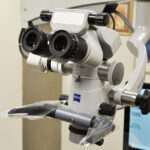
Conventional root canal treatment has good success rates, but root filled teeth may be affected by post-treatment apical periodontitis (AP). Treatment options for AP include nonsurgical retreatment or surgical treatment. Endodontic microsurgery is one increasingly common surgical approach utilising modern microsurgical techniques and operating microscopes.
The aim of this review was to evaluate the clinical and radiographic long-term outcome of endodontic microsurgery in teeth diagnosed with secondary apical periodontitis.
Methods
Searches were conducted in the PubMed/Medline and Cochrane library databases for randomised clinical trials (RCT) and prospective clinical studies (PCS) of endodontic microsurgery, with a follow-up ≥ 2-year using well established clinical and radiographic outcome criteria. Only studies published between January 1990 and May 2020 were considered. Two reviewers selected studies and extracted data. The Cochrane risk of bias tool was used to assess RCTs and the ROBINS-I tool for non-randomised studies and meta-analysis conducted.
Results
- 10 studies (4 RCTs, 6 PCS) were included.
- All 6 PCS studies and 2 RCTS were considered to be at low risk of bias and 2 RCTs at high risk of bias.
- Follow up periods ranged from 2 to 13 years.
- All 10 studies used the same outcome assessment tool.
- Study recall rates ranged from 59-89%; Pooled rate= 61.0% (95%CI; 53.4-68.3%).
- Overall success rates ranged from 69-93%.
- The pooled success rate for RCTs = 91.3% (95%CI; 4–93.8%).
- The pooled success rate for PCS = 4% (95%CI; 73.7–83.1%).
Conclusions
The authors concluded: –
long-term endodontic microsurgery outcome showed high pooled success rates, from 78 to 91% when followed-up from 2 to 13 years. This treatment approach is predictable when performed under modern surgical techniques and survival ranging from 79 to 100%, 2 to 13 years after treatment. Moreover, EMS may be influenced by the following potential prognostic factors: smoking habits, tooth location and type, absence/presence of dentinal defect, interproximal bone level, and root-end filling material. Regarding the root-end filling material, ProRoot MTA showed a trend to better outcome results.
Comments
The authors have restricted their searches to just two major databases which may have resulted in the exclusion of some relevant studies. While two reviews were involved in study selection it is not completely clear whether data extraction or quality assessment was carried out independently. All the included studies were conducted in a Hospital or University environment so the findings might not be generalisable to primary care. While the studies are all have at least 2 years of follow up or longer some consideration of the impact of dropouts on the finding needs to be given. A 2016 Cochrane review compared surgical and non-surgical approaches for endodontic retreatment finding no clear evidence of the surgical or non-surgical approach for healing at one-year follow-up.
Links
Primary Paper
Pinto D, Marques A, Pereira JF, Palma PJ, Santos JM. Long-Term Prognosis of Endodontic Microsurgery-A Systematic Review and Meta-Analysis. Medicina (Kaunas). 2020;56(9):E447. Published 2020 Sep 3. doi:10.3390/medicina56090447
Other references
Dental Elf – 24th Oct 2016
Dental Elf – 26th Jan 2015
Root canal retreatment: review suggests microsurgery better than retreatment
Photo credits
“File:Endodontics microscope.jpg” by Endodontist NYC is licensed under CC BY-SA 4.0
